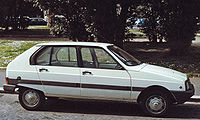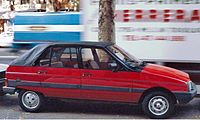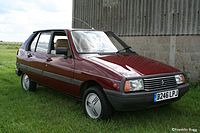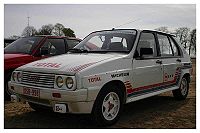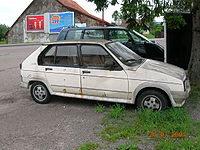- Citroën Visa
-
Citroën Visa Class Supermini Manufacturer Citroën Production 1978—1988 Assembly Rennes, France Predecessor Citroën Ami
Citroën DyaneSuccessor Citroën AX Body style 5-door hatchback
4-door cabrioletLayout FF layout
Front engine, four-wheel driveEngine 652 cc flat-2
954 cc I4
1,124 cc I4
1,219 cc I4
1,360 cc I4
1,580 cc I4
1,769 cc diesel I4Wheelbase 2,436 mm (95.9 in) Length 3,690 mm (145.3 in) Width 1,530 mm (60.2 in) Height 1,410 mm (55.5 in) Curb weight 870 kg (1,900 lb) Related Karenjy Visa (RM)[1]
Wuling LZW 7100 (PRC)[2]The Citroën Visa is a supermini that was produced by the French car marque Citroën from 1978 to 1988.
Contents
Development History
The Citroën Prototype Y to replace the 2CV based Citroën Ami that dated back to 1960 in the early seventies, was originally developed in co-operation with Fiat. It used the then new and advanced Fiat 127 platform, that used a transverse front wheel drive engine, with an end on gearbox layout that Fiat had pioneered in the 1960s. When cooperation with Fiat ended, a new Citroën designed platform was planned. After the takeover of Citroën by Peugeot in the wake of the 1974 oil crisis, the renamed "Projet VD (Voiture Diminuée)" became the Citroën Visa, incorporating the floor pan of the Peugeot 104, to use the advanced 104 engine, with transmission (under the engine) and chassis.[3] It was the first new model under the platform-sharing policy of PSA Peugeot Citroën that continues today. The earlier Citroën LN was just a facelift of the Peugeot 104Z "Shortcut" with a re-engine and transmission from the Citroën Dyane. Eventually, in 1984, the original Citroën platform design from "Project Y" emerged as an Oltcit in Rumania and was also sold in Western Europe as the Citroën Axel: this project was problematic for Citroën due to build quality issues.[4] The Axel was never sold in the UK.
The Visa was launched as a supermini competitor for the likes of the Chrysler Sunbeam, Mk1 Renault 5, Mk1 Ford Fiesta, Vauxhall Chevette, Mk1 VW Polo and Fiat 127.
Models
From its launch in September 1978,[5] the Visa was available in "Spécial" and "Club" models (652 cc, 2-cylinder), and a "Super E" model (the 11RE after 1984), with the advanced Peugeot 1,124 cc Douvrin engine / PSA X engine, a four-cylinder "Suitcase engine" — all aluminium alloy, chain driven overhead cam, with gearbox in the sump, sharing engine oil, mounted almost on its side. The 1124 cc was as economical as the Citroën 2CV-derived twin, but with much better performance. Later on it had 1,219 cc (Super X) and then 954 cc (10E after 1984) and 1,360 cc (1983 Visa GT and 14TRS after 1985) versions of the same engine. In 1982 the Visa underwent a major external restyling, designed by Heuliez, to look more mainstream. It kept the original interior and "PRN Satellite" controls until 1985 when, along with the Citroën BX, it was updated with a new bulkier dashboard, instruments and switchgear that made the car feel smaller inside. Stalk switchgear like contemporary Peugeots added self-cancelling indicators. It had very soft, but well damped, long travel, fully independent suspension (Coil-sprung MacPherson struts at the front, with coil sprung trailing arms at the rear) that caused it to have a soft ride[6] like the Citroën 2CV, but without such extreme roll angles.
CAR magazine made the Visa diesel one of its top ten models on the market for two years running in the mid-1980s (January 1986 and 1987), for its versatility (higher models in the range had split rear seats which could be lifted-out to give an almost van-like luggage capacity); ride comfort ("like a limousine"); its ability to maintain high average speeds due to high levels of grip; and value for money. It was also particularly aerodynamically stable at high speeds for a relatively light, narrow and tall car. It would remain unperturbed by cross-winds and truck bow waves at motorway speeds. It also had at the middle 'R' trim level and above, (currently unfashionable), but practical, grey plastic side rubbing strips, to protect against car park damage. The front of the revised car, was designed to aerodynamically reduce the deposition of dirt on the headlights, and to reduce the risk of stone chips to the headlights, bonnet and windscreen. Long time CAR magazine columnist, the late George Bishop, actually bought one with his own money. Before the advent of the diesel model, the electronic ignition, high compression engined Super E / 11RE with high gearing, was the best seller in the range. It was better equipped than the base Austin Metro and Ford Fiesta it was priced against, having height adjustable halogen headlights, rear wash-wipe and multi-speed front wipers, removable split folding rear seats, as well as five doors when its competitors only had three, (the five-door Metro was launched in 1985). A five speed gearbox was optional, when the base model competitors could only be had with a four speed. The 1984 954cc 10E model was a direct competitor on specification to the Metro and Fiesta, but significantly undercut them on price.
A four-door convertible version of the 11RE was also produced in the Heuliez factory from 1984. This was heavier and slower than the hatchback that it was based on.
In spring 1984 the very successful diesel version was added. The Visa 17D and 17RD used the famously rugged and refined, class-leading 1,769 cc XUD diesel and transmission from the Peugeot 205. It also capably powered the Peugeot 405, which was two classes larger, and made light work of powering the lightweight Visa. It had too wide a track for the original engine compartment and wings, so the front wings were extended with large black plastic wheel arch panels. The spare wheel that in smaller petrol engine versions, was mounted on top of the flat or near horizontal engine, was bolted to the otherwise flat boot floor — compromising luggage space. In continental Europe, a basic diesel van the 'Visa Enterprise' was sold that used the normal Visa bodyshell with the rear doors welded shut.[7] It mounted a spacesaver spare wheel under the bonnet, over the diesel engine.
At the Paris Salon 1984, for model year 1985, the 1.4 L TRS was presented.[8] The Visa 14 TRS, was produced for two years (1985–1987), shared its engine with the Citroën BX14. Even though it received a favourable review by CAR magazine[9] who felt it was a better performance/economy compromise than the 11RE, it wasn't very successful, due to being squeezed by the Visa Diesel and the extremely competitively priced BX 14.
Between 1985 and 1987 the 1.1l petrol and 1.7l diesel leader special editions were marketed.[10] In the latter half of the eighties a 55 PS (40 kW) catalyzed version of the 1,360 cc engine was added for markets with stricter emissions standards.[11]
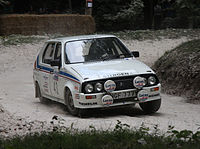 Citroën Visa Trophée Rally car at Goodwood 2010
Citroën Visa Trophée Rally car at Goodwood 2010
Sporting versions
The first sporting versions of the Visa included the "Visa GT" (1.4 L with double-barrel carburettor and 80 hp (59 kW) DIN), the "Visa Chrono" (93 hp (68 kW) from the 1.4 L engine, this time with two double-barrel carbs). The Visa "Mille Pistes" (112 hp (82 kW) and four-wheel drive) was the rare production version of Citroen's successful (if unlikely looking) Visa rally car, the Visa Chrono and Chrono II.
At the Paris Salon 1984, for model year 1985, the high-performance 1.6 GTi was presented.[8] The GTi used the 1.6 L fuel injected XU5J engine amd transmission combination (105 or 115 hp (77 or 85 kW) versions) from the successful Pininfarina styled Peugeot 205 GTI. Citroën gave the GTi plastic wheel arch extensions and quad round headlights, to differentiate the model and try to make it look more sporty. It received good reviews about its ride, performance and roadholding, but due to its older, failed facelift looks and its five-doors, even with a much lower price than the chic 205 it was not a big seller.
End
The Visa hatchback ceased production in 1988, and was only partially replaced in the Citroën range by the smaller and less commodious 1987 five-door Citroën AX.
The 1985 Citroën C15 diesel box van version of the Visa continued to be produced until 2005, (although the petrols were phased out in the early 1990s), due to its practicality (able to load a standard pallet) and low running costs, even though the 1996 Citroën Berlingo was supposed to replace it. The C15 was also the basis of the Romahome camper van.
The Visa's downsides were body corrosion (improved on later versions), a plasticky interior with fabrics that could wear badly, and its styling. Almost every contemporary road test found the styling controversial. The Douvrin engine, as used in the pre-1988 Peugeot 205 and 1.4 litre Citroën BX, means that changing a clutch requires that the entire engine and gearbox unit first has to be removed.
In the United Kingdom, there were nearly 20,000 examples still registered in 1994, but by 2002 that figure had fallen below 1,000 and as of 2011 there are now a mere 136 still registered, 95 of them SORN and a mere 41 still in working order.[12] Even though there is not a huge amount of Visas remaining, there is still a very enthusiastic following within the Citroen Car Club and The Citroen Visa Forum too. At most large gatherings and rallies organised by the Citroen Car Club there is normally a good attendance of Visas.
Twenty years after it ceased production, the large glass area, and the narrowness of the Visa with its tucked in door mirrors, with its suspensions ability to totally absorb large bumps in the road, make the few remaining examples better adapted to the modern so-called 'traffic calmed' urban environment, than most of the current generation of (albeit more crashworthy) cars that are much wider and/or have very firm suspensions.
Bodywork
The Visa lacked the Peugeot's three-door hatchback option, being available only as a five-door hatchback. A light van using the front of the Visa, along with a conventionally sprung version of the Citroën BX rear suspension, was also produced - the Citroën C15. It was a box van, as pioneered by Citroën with the Citroën 2CV Fourgonette/AK vans and the Citroën Dyane based Acadiane van.
Engines
Engine Code Engine Type Cubic Capacity (cc) Maximum Power Maximum Torque V06/630, V06/644, V06/665 2 cylinders (Boxer) 652 35 PS (26 kW; 35 hp) at 5250 rpm 48 N·m (35 lb·ft) at 3500 rpm XV8 4 cylinders 954 45 PS (33 kW; 44 hp) at 6000 rpm 65 N·m (48 lb·ft) at 2750 rpm XW7 4 cylinders 1,124 50 PS (37 kW; 49 hp) at 5500 rpm 83 N·m (61 lb·ft) at 2500 rpm XZ5X 4 cylinders 1,219 64 PS (47 kW; 63 hp) at 6000 rpm 91 N·m (67 lb·ft) at 3000 rpm XY7 4 cylinders 1,360 60 PS (44 kW; 59 hp) at 5000 rpm 105 N·m (77 lb·ft) at 2500 rpm XU5J 4 cylinders 1,580 115 PS (85 kW; 113 hp) at 6250 rpm 131 N·m (97 lb·ft) at 4000 rpm XUD7 4 cylinders diesel 1,769 60 PS (44 kW; 59 hp) at 4600 rpm 112 N·m (83 lb·ft) at 2000 rpm TV commercials
- Citroën Visa GTI 1988 (YouTube Video)
References
- ^ "Zébu roulant - Madagascar : une île en sursis - Blog LeMonde.fr". Madagascar.blog.lemonde.fr. 2010-03-24. http://madagascar.blog.lemonde.fr/2010/03/24/zebu-noir/. Retrieved 2010-08-06.
- ^ Par Joest Jonathan Ouaknine le 19 novembre 2007. "Un(e) Visa pour la Chine » » le blog auto: l'actualité automobile et sport automobile en temps réel". le blog auto. http://www.leblogauto.com/2007/11/une-visa-pour-la-chine.html. Retrieved 2010-08-06.
- ^ "Projet Y - Citroënet". http://www.citroenet.org.uk/prototypes/projet-y-ta-vd/projet-y.html. Retrieved 2010-01-07.
- ^ "www.citroenvisa.net The Visa section - introduction.". http://www.citroenvisa.net/vindex.htm. Retrieved 2010-01-07.
- ^ http://news.google.com/newspapers?id=SAI-AAAAIBAJ&sjid=cUkMAAAAIBAJ&pg=5910,4829885&dq=chrysler-horizon&hl=en
- ^ "Citroën Visa - Citroënet". http://www.citroenet.org.uk/passenger-cars/psa/visa/visa01.html#visa. Retrieved 2010-01-07.
- ^ "Visavision". Visavision.info. http://visavision.info/models.htm. Retrieved 2011-09-28.
- ^ a b Büschi, Hans-Ulrich, ed (March 5, 1987) (in German/French). Automobil Revue 1987. 82. Berne, Switzerland: Hallwag AG. p. 231. ISBN 3-444-00458-3.
- ^ CAR magazine 1985
- ^ "Visavision". Visavision.info. http://visavision.info/models.htm. Retrieved 2011-09-28.
- ^ Automobil Revue 1987, p. 232
- ^ [1]
- ^ "Citroën Visa and C15". Citroenvisa.net. http://www.citroenvisa.net/vindex.htm. Retrieved 2011-09-28.
External links
Type 1950s 1960s 1970s 0 1 2 3 4 5 6 7 8 9 0 1 2 3 4 5 6 7 8 9 0 1 2 3 4 5 6 7 8 9 Economy car 2CV Off-roader Méhari Supermini LN / LNA Dyane Ami Visa Small family car GS Large family car 11 CV ID / DSpécial / DSuper Executive car 15 CV DS CX Grand tourer SM « previous — Automobiles Citroën, a subsidiary of the PSA Peugeot Citroën since 1976, car timeline, 1980s–present Type 1980s 1990s 2000s 2010s 0 1 2 3 4 5 6 7 8 9 0 1 2 3 4 5 6 7 8 9 0 1 2 3 4 5 6 7 8 9 0 1 Economy car 2CV Off-roader Méhari City car C1 Supermini LN / LNA AX Dyane Axel Saxo I Saxo II C2 DS3 Visa C3 I C3 II Small family car GSA ZX Xsara I Xsara II C4 I C4 II DS4 Large family car BX Xantia C5 I C5 II DS5 Executive car CX XM C6 Leisure
activity vehicleAcadiane C15 Nemo Berlingo Berlingo II Compact
MPVXsara Picasso C3 Picasso C4 Picasso Large MPV Evasion/Synergie C8 C4 Grand Picasso Crossover C-Crosser Convertible C3 Pluriel Van H Van C25 Jumpy I Jumpy II C35 Jumper Jumper II Categories:- Citroën vehicles
- Subcompact cars
- Front wheel drive vehicles
- Vehicles with boxer engines
- Hatchbacks
- 1970s automobiles
- 1980s automobiles
- Vehicles introduced in 1978
Wikimedia Foundation. 2010.




